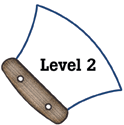
Alaska Science
Key Element B3
A student who meets the content standard should understand that scientific inquiry often involves different ways of thinking, curiosity, and the exploration of multiple paths.
 |
Alaska Science A student who meets the content standard should understand that scientific inquiry often involves different ways of thinking, curiosity, and the exploration of multiple paths. |
|
Performance Standard Level 2, Ages 8–10
|
|
|
|
Sample Assessment Ideas
|
Standards Cross-References
|
||
|
National Science Education Standards Ask a question about objects, organisms, and events in the environment. This aspect of the standard emphasizes students asking questions that they can answer with scientific knowledge, combined with their own observations. Students should answer their questions by seeking information from reliable sources of scientific information and from their own observations and investigations. (Page 122) Communicate investigations and explanations. Students should begin developing the abilities to communicate, critique, and analyze their work and the work of other students. This communication might be spoken or drawn as well as written. (Page 122) Recognize and analyze alternative explanations and predictions. Students should develop the ability to listen and to respect the explanations proposed by other students. They should remain open to and acknowledge different ideas and explanations, be able to accept the skepticism of others, and consider alternative explanations. (Page 148) |
Benchmarks Scientists’ explanations about what happens in the world come partly from what they observe, partly from what they think. Sometimes scientists have different explanations for the same set of observations. That usually leads to their making more observations to resolve the differences. (Page 11) Offer reasons for their findings and consider reasons suggested by others. (Page 286) |
|
Table of Contents | Return to Alaska Native Knowledge Network